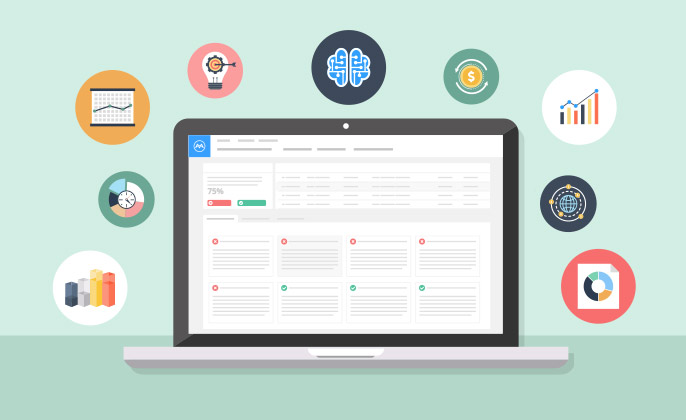Today’s audit environment is more dynamic, complex and growing than ever before concerning financial data. The challenges with globalization, the growing Internet, Big Data and ERP systems with multiple touch points fuels the growth of financial data and challenges the ability of professional accounting firms to assert high-levels of confidence in performing audits.
However, with the recent advancements in technologies such as artificial intelligence (AI), auditors can augment their capabilities to sift through and analyze these large amounts of data.
At MindBridge™ Ai, we utilize a hybrid of tests including machine learning based algorithms, rules-based tests, and statistical models, against each transaction in the complete financial dataset. Through the analysis of 100% of the records, the results are presented to the user in an intuitive, visual interface which augments the capabilities of audit and investigative professionals by allowing them to focus their analysis on the most relevant activities. MindBridge Ai has elevated the definition of ‘reasonable assurance’ to help auditors ensure financial data is free of errors, and potentially intentional misstatement. Accounting and auditing firms across the world are acknowledging the value of AI and are using it as a competitive advantage.
One such forward-looking firm is KNAV P.A., a KNAV International Limited firm that has recently adopted MindBridge AI Auditor™. KNAV International Limited is a not-for-profit, non-practicing, non-trading corporation incorporated in Georgia, USA, and it has more than 400 professionals and 42 partners in nine locations across the world. I recently sat with Atul Deshmukh, Global Leader of Assurance Services, at KNAV to learn how he plans to transform the auditing business with the use of AI.
Let’s meet Atul!
John Colthart: Tell us about KNAV.
Atul: KNAV International Limited is an association of global accounting and consulting firms, founded in 1999, that offer a complete suite of public accounting services—including set-up, accounting, assurance, taxation, international transfer pricing, risk advisory and business advisory services—and facilitate seamless business growth through mergers and acquisitions.
Today, KNAV is an international organization comprised of more than 400 professionals and 42 partners in nine locations (India, the United States, Canada, Switzerland, Singapore, France, the Netherlands, the United Arab Emirates and the United Kingdom).
Working with some of the largest and most recognized multinational companies, KNAV enables clients to comply with financial reporting, regulations, and taxation across multiple geographies. KNAV P.A., our US public accounting firm, is headquartered in Atlanta, Georgia and is the US founding member firm of KNAV International Limited. KNAV P.A. is also a member of Allinial Global, an association of independent accounting firms within North America and the rest of the world. The resources of Allinial Global are comparable to those of a “Big Four” firm. Allinial Global firms share ideas, training resources, best practices and, most importantly, knowledge as needed to meet the needs of their clients anywhere in the world. Although member firms are owned and managed independently, there is substantial collaboration among the members, allowing member firms to better serve clients in a wide range of industries.
John Colthart: What do you see as your biggest opportunity?
Atul: At KNAV P.A., we foresee a tremendous growth in investments by multinational companies, specifically companies from India or in North America and companies that thrive on the Indo-US business model. Our presence in Atlanta and the Bay Area in the US and across various cities in India and our ability to provide audit, tax and advisory services in the US and India to these multinational companies are our biggest opportunities. We have a leadership position in this niche market, and we expect to continue to grow in this market segment.
John Colthart: What do you see as the biggest threat or challenge?
Atul: The need to keep abreast of changing accounting and reporting standards, the complexity of conducting audits of large public multinational companies and the challenges of ever-changing tax laws continue to be our biggest threats and challenges. Coupled with the increasing complexity within our service delivery, the dearth of skilled and trained resources within our niche segment creates a high-risk environment for our firm. The huge investments that larger accounting firms are making in technology will effectively level the price differentiation between these firms and smaller firms such as ours. Losing our coveted space in our market segment to larger firms is a threat that is real and imminent.
John Colthart: How do you plan to address it?
Atul: KNAV has established a special task force to keep the firm abreast of the latest developments in accounting, auditing and taxation. We are heavily investing and relying on technology to mitigate the risk arising from the deficiency of skilled and trained professionals in the marketplace. We continuously seek ways to get a first-mover advantage by embracing state-of-the-art tools and techniques that enhance the accuracy and efficiency of our services. In this context, the use of AI for data mining and analytics is a strong step that we have taken to dramatically improve and enhance the efficiency of our professional audit staff.
John Colthart: What made you choose MindBridge Ai Auditor™? What are the features that you plan to use?
Atul: We at KNAV felt that a unique solution such as MindBridge AI Auditor™ would allow us to provide a more time-efficient, more economical, more rigorous and higher quality audit, which provides an elevated level of assurance to our clients. Since our focus is on having stronger analytical, data science and IT skills to complement our financial and cross-border business acumen, we were clear that this tool would help us tremendously in making our audit process faster, more reliable and more efficient. In today’s digital world, it is critical for the audit profession to embrace advanced technology tools—including robotics, automation, and cognitive technology.
The smart data import, out-of-the-box integration with leading ERP and accounting software, features related to risk-based scoring, user-interface design and transaction sampling are the key features of the MindBridge AI Auditor™ that would enable the KNAV team to work closely with the client. The fact that we are exposing each and every transaction from the client general ledger to 26 rigorous tests is a game changer. Never before have we been able to conduct such an in-depth analysis of client data at the transaction level.
To see an announcement of our relationship with the KNAV P.A., please click here.














